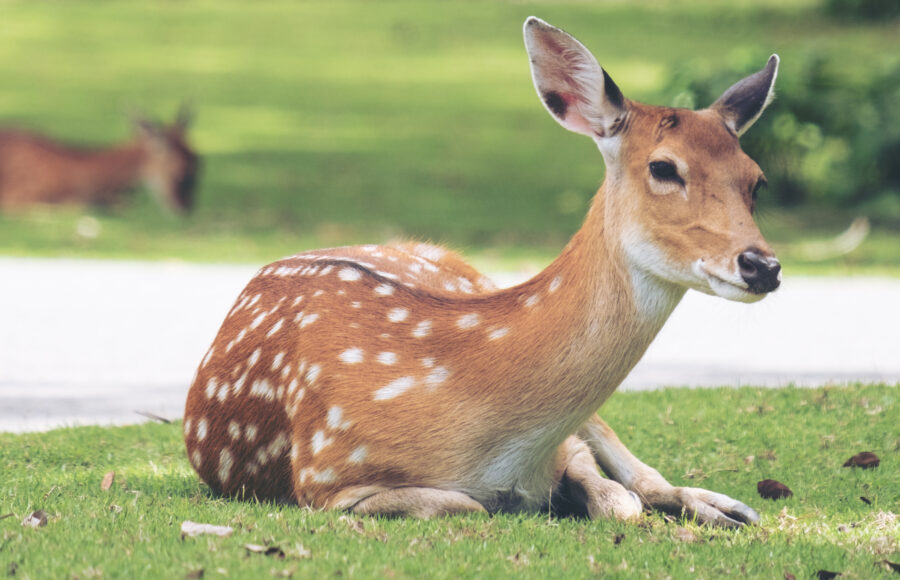DEER
DO’S:
For your garden, choose flowers and shrubs that are unpalatable to deer, such as forsythia, lilac bush, marigolds, zinnias, daffodils, lavender and snapdragons. State Departments of Natural Resources may have specific recommendations in your area.
Spray flowers and shrubs with a deer repellant that contains a mixture of dried bovine blood, sulfured eggs and garlic. These repellants are available at most home and garden stores. They will not harm your plants and are usually effective in deterring deer.
Install motion-sensitive spotlights in garden areas to frighten approaching deer at night.
Install fencing around garden areas. During the growing season when natural vegetation is plentiful, fencing is typically effective. However, when natural food is scarce, fencing may not deter deer as they can jump up to 10 feet.
DON’TS:
Don’t use repellants that contain the urine of predators, such as bobcats or foxes. This urine is often collected from animals that are housed and treated inhumanely.
BATS
DO’S:
Use caution when dealing with bats — they are the primary source of human rabies in the United States.
Because bats are insectivores that consume mosquitoes and other flying bugs, consider placing bat houses in your yard.
Regularly check roofs and attics for any holes or gaps and seal them immediately (making sure no bats are trapped inside). Keep in mind that bats can fit through holes less than 1/2” wide.
If you do find bats in your attic, evict them humanely by installing a “one-way door” at their entrance hole. You can find their point of entrance by watching from the ground at dusk when they leave the attic to feed. Make a “one-way door” by installing a piece of netting as a flap. Bats will be able to crawl under the flap to get out, but will not be able to lift the flap to get back in. To ensure all bats exit, leave the “one-way door” in place for several days and then permanently seal the hole.
Wear heavy leather gloves when attempting to catch and release bats that have gotten into your home. Bats have very small teeth and cannot bite through leather. If you are bitten or suspect that you have been bitten, contact your local health department immediately.
DON’TS:
Don’t assume there are no bats in your home just because you have not seen any enter or exit. If you find a hole, assume there may be bats and check your attic thoroughly before sealing it. Trapped bats will starve to death!
SKUNKS
DO’S:
Consider simply coexisting with these gentle creatures. Skunks are naturally docile and non-aggressive. If you see one in your yard, it is best to just leave it alone and let it leave on its own time.
If you don’t want skunks living under your deck or shed, seal these areas with chicken wire. Leave at least one foot of additional wire on the ground extending from the structure to prevent skunks from digging under to enter.
If a skunk is living under your deck or shed, spray the area with a mixture of castor oil and dish-washing detergent diluted in water. Spray the area at night when the skunk is away foraging. When it returns to the den, it will find this odor offensive and will likely seek a new den. Once you are sure the skunk is gone, thoroughly seal the area with chicken wire.
Remove any possible food sources in your yard. Skunks are omnivores and will be attracted to pet food as well as bird seed.
DON’TS:
Don’t seal off an area unless you are certain that the skunk and any babies are gone. Animals that are trapped will starve to death.
Do not trap and relocate skunks. While humane traps will not harm these animals, relocation is a poor choice. Studies have shown that many species of wildlife do not survive when placed in a new territory because of aggression from other animals, unfamiliarity with hazards such as roadways, or the inability to find food and water. Remember that this animal was born and raised within about a one-mile radius. Moving it even a few miles away can have devastating effects. Also, if the animal is female there is a high likelihood you will remove her from babies that depend on her for survival.
SQUIRRELS
DO’S:
Place birdfeeders at least 8 feet off the ground and away from trees or structures. Squirrels can leap very far.
Buy birdfeeders equipped with squirrel “bafflers.” These devices hang below birdfeeders and prevent squirrels from getting to the birds. They are most effective when placed in the yard for the first time — installing bafflers on existing feeders that squirrels are already accustomed to raiding only temporarily sets them back. Determined squirrels can chew through or leap over most baffling devices.
Cap chimneys where squirrels like to live.
Regularly check roofs and attics for any holes and gaps and seal them immediately (making sure no squirrels are trapped inside).
If you do have a squirrel nesting in your chimney or attic, try frightening it away by playing loud music. After you are certain the squirrel has fled and there are no babies left behind, seal the area. If there are babies in the nest, wait until they are weaned at roughly 10 weeks of age before attempting to evict them.
DON’TS:
Do not coat birdfeeder poles with sticky repellants or hot sauce or use birdseed that contains capsaicin (hot pepper). These methods may repel squirrels, but they can be detrimental to their health. Birds are not affected by hot sauce and hot pepper, but sticky substances can affect their ability to fly.
Don’t trap and relocate squirrels. This is a losing battle since the population of squirrels is extremely high. Also, if the animal is a female there is a high likelihood that you will remove her from babies that depend on her for survival.
Don’t seal off an attic or chimney unless you are certain the squirrel and any babies are gone. Animals that are trapped will starve to death.
Don’t light a fire in your fireplace if you suspect a squirrel is nesting in your chimney. The mother squirrel may escape, but the babies in the nest likely won’t.
RACCOONS
DO’S:
Keep garbage cans inside until the morning of pickup.
Buy garbage cans with locking lids.
Keep pet doors sealed shut between dusk and dawn. Raccoons have been known to enter houses through pet doors at night and help themselves to food.
Remove any possible food sources in your yard. Raccoons are omnivores and will eat just about anything, including pet food and bird seed.
Cap your chimneys.
Regularly check roofs and attics for any holes and gaps and seal them immediately (making sure no raccoons are trapped inside).
If you have a raccoon in your attic, try driving it away with gentle harassment. If it must endure bright lights or loud music, it may decide to relocate. Once you are certain that the raccoon and any babies are gone, seal the area.
DON’TS:
Don’t leave unlocked garbage cans or plastic bags in your yard or at the curb these are an open dinner invitation to raccoons.
Don’t leave pet doors open at night.
Don’t seal off an area unless you are certain the raccoon and any babies are gone. Animals that are trapped will starve to death!
Do not trap and relocate raccoons. While humane traps will not harm these animals, relocation is a poor choice. Studies have shown that many types of wildlife do not survive in a new territory. Also, if the animal is a female there is a high likelihood you will remove her from babies that depend on her for survival.
Don’t light a fire in your fireplace if you suspect a raccoon is nesting in your chimney.
RABBITS
DO’S:
Know what you’re dealing with. Rabbits are not only prolific but also voracious eaters. It only takes a couple to completely decimate a vegetable garden or flower bed.
Erect a fence of chicken wire around the area you want to protect. Make sure the fence is at least 2 feet high and supported by posts at 6-foot intervals. The bottom of the fence needs to be staked securely to the ground to prevent rabbits from slipping under it.
Treat them like deer. Rabbits find the same type of plants unpalatable as deer do. Choose plants such as forsythia, lilac bush, marigolds, zinnias, daffodils, lavender and snapdragons. Rabbits also may be deterred using commercially available deer repellents that contain a mixture of dried bovine blood, sulfured eggs and garlic.
DON’TS:
Poison or shoot them.
Depend on repellents alone — they may be ineffective as rabbits are not always sensitive to offensive odors.
Think you can approach them hastily and scare them away. Rabbits are less wary of humans than deer are.
RABIES TIPS:
All mammals can carry rabies.
Bats pose the greatest risk for humans because of their propensity to get into attics and human living spaces.
If you see a wild animal that is acting strangely — being too friendly toward humans, being aggressive, circling, or having trouble walking — the animal could have rabies. Remain at a safe distance and call your local health department or animal control agency.
Many people believe that raccoons out in daylight may have rabies. In fact, it is not unusual to see raccoons out during the day. If the animal is acting normally, let it be.





